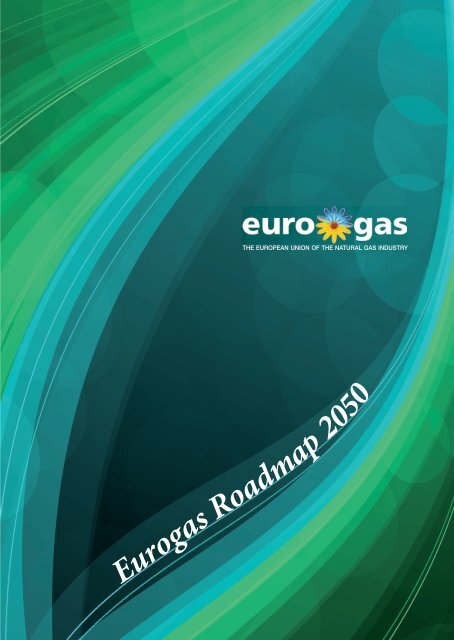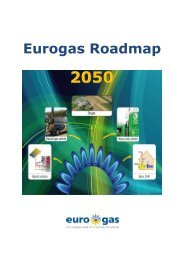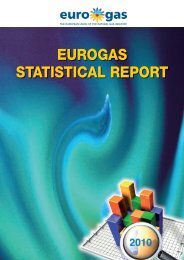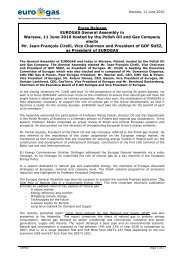Eurogas Roadmap 2050 - summary
Eurogas Roadmap 2050 - summary
Eurogas Roadmap 2050 - summary
You also want an ePaper? Increase the reach of your titles
YUMPU automatically turns print PDFs into web optimized ePapers that Google loves.
THE EUROPEAN UNION OF THE NATURAL GAS INDUSTRY<strong>Eurogas</strong> <strong>Roadmap</strong> <strong>2050</strong>
EUROGASROADMAP<strong>2050</strong>This study by <strong>Eurogas</strong> sets out to describe whatEurope’s energy balance might look like in <strong>2050</strong>,while achieving an 80% reduction of domesticgreenhouse gas emissions (GHGs) in the EU, comparedwith 1990, as proposed by the EuropeanCommission in the “<strong>Roadmap</strong> for moving to alow-carbon economy in <strong>2050</strong>”.The <strong>Eurogas</strong> <strong>Roadmap</strong> <strong>2050</strong> is aimed at showingone of the possible pathways to achieve the 80%target by reducing emissions in all energy relatedsectors. This pathway concerns the EU27 as a whole.National policies and companies’ strategies canthere fore lead to other low-carbon scenarios ineach country. The study acknowledges that thescale of the transformation in the way that Europe’scitizens and firms use, distribute and make energywill be significant, if the deep cuts in emissions areto be achieved. It recognises that <strong>2050</strong> is a long wayaway and that technological and social changes canhave profound impacts over such a timeframe.<strong>Eurogas</strong> brings a distinctive angle to the forthcomingdebate around the Energy <strong>Roadmap</strong> <strong>2050</strong> that theCommission intends to publish in December 2011:◗ We show how natural gas can contribute to reducinggreenhouse gas emissions in the short, mediumand long term, while, thanks to its flexibility,leaving open plausible technological and policyoptions to achieve the <strong>2050</strong> targets.◗ We examine each sector of energy use in detail toidentify the actions which could be undertakenin terms of technology penetration and increasingenergy efficiency, fuel substitution, as wellas behaviour changes. The combination of theseactions enables the reduction of GHG emissions
in <strong>2050</strong> compared with 1990 by 71% in the residentialand services sector, 83% in industry, 69%in transport and 93% in power generation. In totalthis achieves an 82% reduction of domesticgreenhouse gas emissions, as considered necessaryfor Europe to make a leading contributionto limiting climate change.The <strong>Eurogas</strong> <strong>Roadmap</strong> shows that realising thepotential of natural gas uses and technologies in allsectors is an effective way of achieving greenhousegas emissions compliant with the European Commission’starget. It considers the specific capabilityof natural gas to act as an important enabler ofzero-carbon renewables, and provides a view to<strong>2050</strong> of a system that remains flexible in today’schoices and keeps open options for tomorrow.The forty-year period of the study can be subdividedinto two phases. The use of gas is clearly beneficialalong the whole way to a sustainable future:From today to 2030: The high efficiency and lowemissions of CO 2that gas provides, in heatingand in power generation, will make a direct andimmediate contribution to the reduction of GHGemissions in the EU. Furthermore, the flexibilityof gas combines perfectly with the development ofrenewable sources.Between 2010 and 2030, the <strong>Eurogas</strong> <strong>Roadmap</strong>foresees a key role of natural gas in a low-carboneconomy with an increase of the share of naturalgas in primary energy consumption from around26% in 2010 to 30% in 2030. In this timeframe, the<strong>Eurogas</strong> <strong>Roadmap</strong> foresees the sectoral evolutionof natural gas as follows:◗ In the EU27 residential and services sector, themarket share of gas could decrease from around40% to 35%. Since the total final energy consumptionof the sector is expected to decrease,gas sales volumes could drop from 210 bcm in2010 to 152 bcm in 2030.◗ For the industry sector, the market share of gasshould remain stable at close to 30% with volumesmoving from 106 bcm to 114 bcm.◗ Natural gas today has only minor use in transport(1 bcm). In 2030, natural gas should reach amarket share of 5% for passenger transport and13% for freight.◗ For power generation, natural gas should see itsmarket share increase from 20% to 25% between2010 and 2030 (moving from 162 bcm to 203bcm).From 2030 to <strong>2050</strong>: After 2030, the <strong>Roadmap</strong>sees the need for the development of natural gaspower plants and industrial plants equippedwith carbon capture and storage (CCS) technology.These can operate at high load factors whilehaving a low carbon dioxide impact thanks to theapplication of CCS. There will also remain a needfor flexible gas-fired plants to support the necessarylarge-scale development of variable zerocarbonrenewables. Together, these factors implythat gas volumes dedicated to the power sectorremain almost stable in the <strong>Eurogas</strong> <strong>Roadmap</strong>,with 191 bcm in <strong>2050</strong> compared with 162 bcm in2010. In the industry sector, CCS deployment willallow natural gas to maintain its market share whilesignificantly contributing to the achievement of theCO 2emissions reduction target. The final energyconsumption of the residential and services sectorcould decline as efficiency and behaviour changeprovide a large part of the emissions reductioneffort. While in this sector the natural gas marketshare stands at 23% in <strong>2050</strong>, volumes would drop to86 bcm. As for the transport sector, the naturalgas market share should increase between 2030and <strong>2050</strong>, reaching 13% and 33% respectively forpassenger and freight transport and representing avolume of 33 bcm in <strong>2050</strong>.
600500400356Primary Energy Consumpon in EU 27 -<strong>Eurogas</strong> <strong>Roadmap</strong>Natural Gas54452247421 281061144624033Bcm300200340120210152112861000140162203 191631990 2010 2030 <strong>2050</strong>Power generaon Residenal & Services Industry Transport Others**including district heang, raw material and energy branchGas therefore opens up options for a Europeanenergy future that requires progress to a lowcarboneconomy. The balance between zerocarbonrenewables and CCS in the far distantfuture is unknown today. By investing in gas,there is an option to go in either direction inthe longer term, i.e. to go in whichever directiontechnology and economics may point atthe time. And in doing so, immediate reductionsin emissions can be achieved today bysubstituting gas for higher carbon fuels andby adopting equipment that improves theefficiency with which energy is used.The European gas industry is stronglycommitted to working in the direction outlinedin this <strong>Roadmap</strong>. To ensure that naturalgas can deliver its potential contribution,the industry needs a stable and predictablepolicy framework that encourages investment.Alongside the penetration of new technologies,there is a large potential for complementaryand supportive development of natural gasand zero-carbon renewables.
1009010022GHG emissions*<strong>Eurogas</strong> <strong>Roadmap</strong> (1990 : 100)898070192880605040181316541957302010040321990 2010 2030 <strong>2050</strong>Power Generaon Residenal & Services Industry Transport Baseline*The study addressed energy related CO 2 emissions by sector. Industrial processes and agriculture have not beenconsidered.101114187353This study provides a route that represents a natural strategy for attainingEurope’s energy and climate goals. A pragmatic, economical and feasible roadmapfor a sustainable energy future has to be based on a large role for natural gas.As this study proposes a prospective scenario compliant with the implementation of the <strong>2050</strong> GHG targets,it does not pretend to be a forecast exercise such as the <strong>Eurogas</strong> “Long term outlook for gas demand andsupply 2007-2030”, which is based on a country-by-country approach.A detailed explanatory note on the <strong>Eurogas</strong> <strong>Roadmap</strong> <strong>2050</strong> can be found on www.eurogas.org
THE EUROPEAN UNION OF THE NATURAL GAS INDUSTRYAvenue de Cortenbergh, 172 - Box 6 - B - 1000 BrusselsTél: +32 2 894 48 48 - www.eurogas.orgEditor: S. Basiu - Concept: Studio A4 - Printing: DB Print








